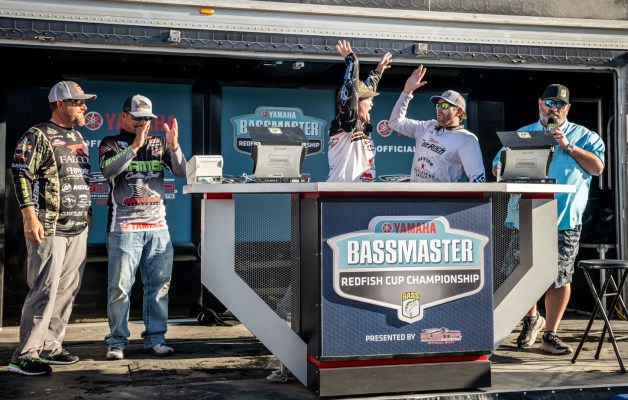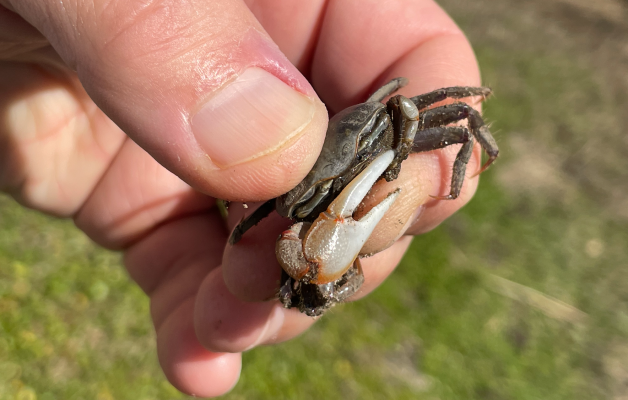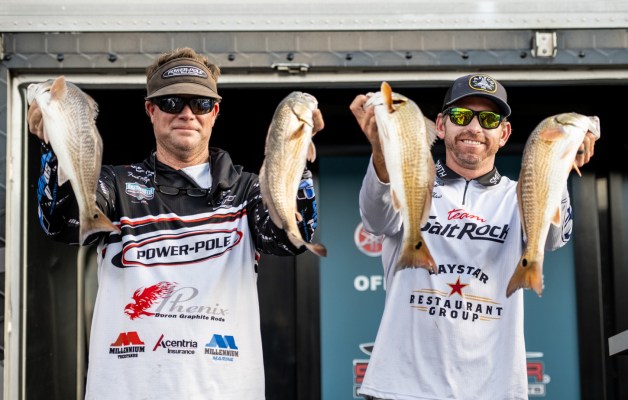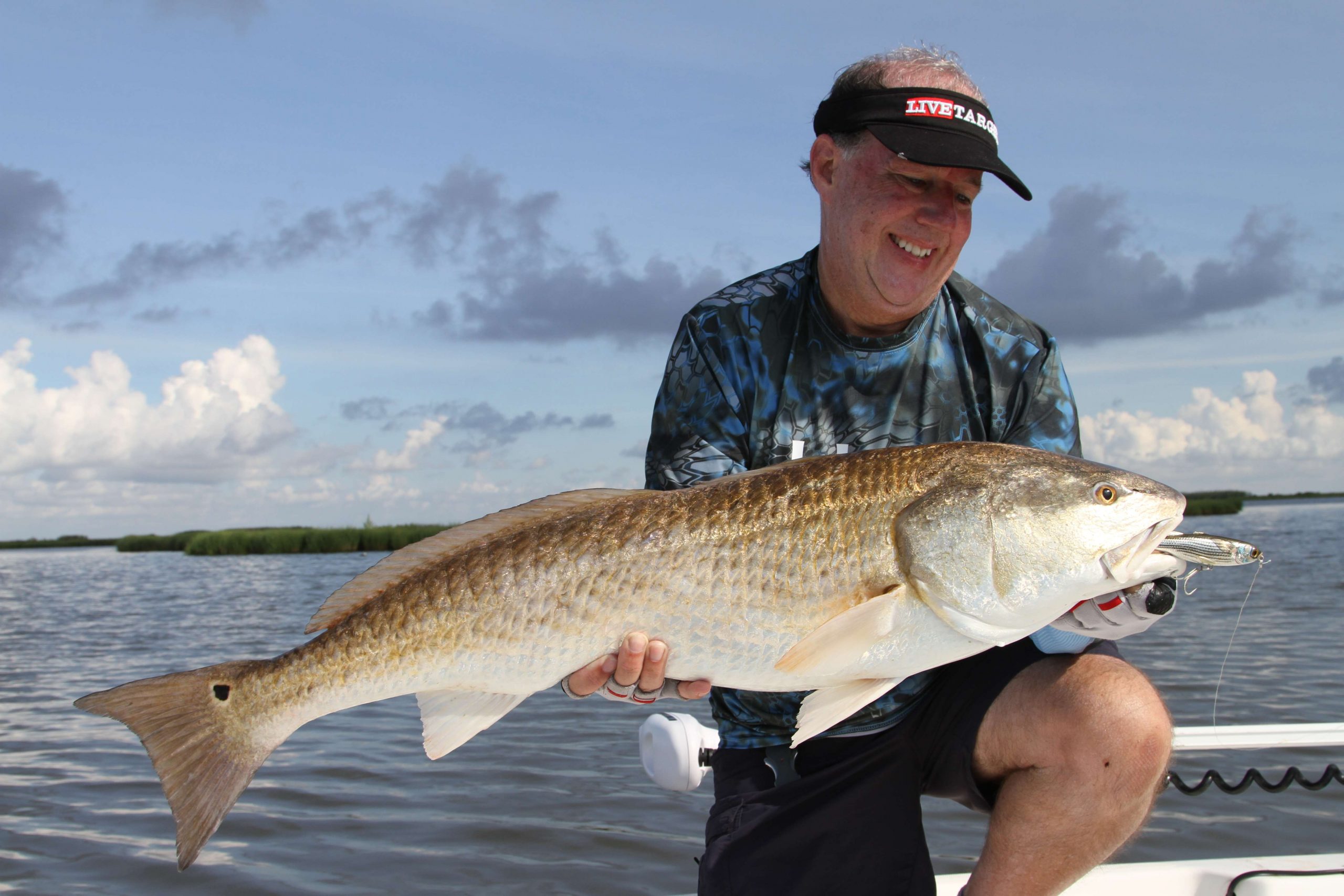
You don’t have to visit Pamplona to experience a running of the bulls. In fact, when you’re fortunate enough to locate massive herds of oversized “bull” redfish, you’ll enjoy the unforgettable thrill of arm-stretching engagement where no one gets trampled, squeezed or gored.
Aren’t all redfish strong fighters? Sure, even the “low slot” fish — those toward the bottom end of the slot limit — tug with impressive vigor often belying their size.
But then there are the bulls. These hulking, oversized fish eclipsing the slot — often by a bunch — epitomize “brute strength.” Nothing fancy, no jumps; just a relentless, low-gear expression of their absolute disdain for whoever interrupted their feeding.
The ensuing battle is one of the toughest in coastal waters and let’s just say you’d better be up for the task, because bulls will test your tackle — as well as your resolve. These fish will take you to your limit and trick you into thinking they’re spent, only to rip off another tortuous run.
To the victor goes the spoils? Well, sometimes. After the blackened redfish craze of the 1980s decimated Gulf stocks, federal waters were closed to harvest, while states tightened up their regulations.
Currently, four of the five Gulf states allow the harvest of over-slot fish — Texas (two over 28 inches), Louisiana (one over 27), Mississippi (one over 30), Alabama (one over 26) — so most bulls are released alive. Nevertheless, these impressive fish, with their glistening copper scales and distinctive tail spots (sometimes multiples) are pretty good about sitting still for one of the most Instagram-worthy bragging rights photos you’ll ever take.
So how big do bull reds grow? Consider the Gulf of Mexico’s state records:
Texas: 59 pounds, 8 ounces
Louisiana: 61-0
Mississippi: 52-2
Alabama: 43-0
Florida: 60-2
North Carolina’s Hatteras Island produced the world record: 94-2 in 1984.
Granted, such whoppers are less common, but schools of oversized reds will offer plenty of shots at fish in the 15- to 30-pound range. For most folks, that’s more than enough to ding the ego bell.
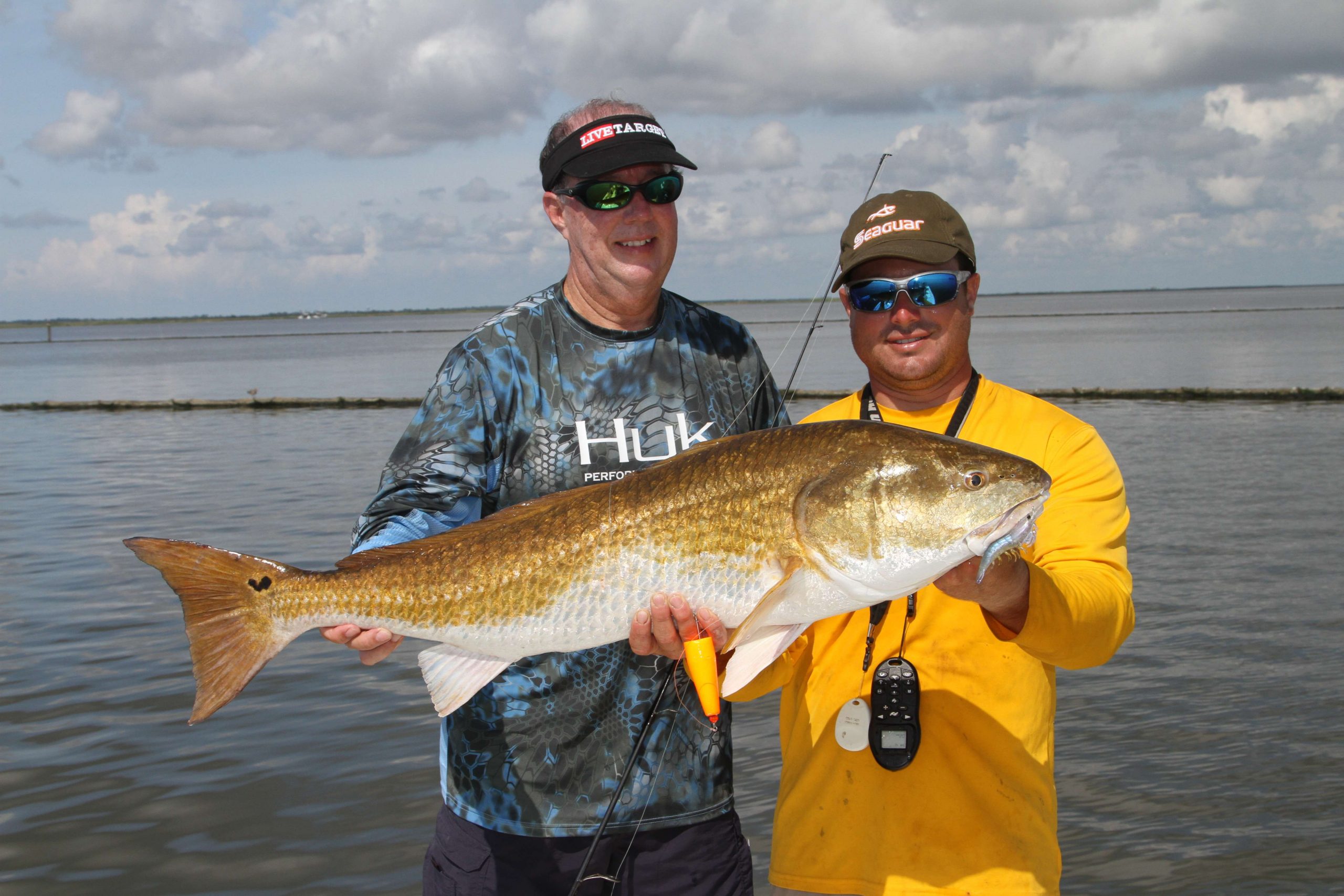
Where to find them
Bull reds live a different life than the juvenile slot-sized fish that grow up in the marshes and estuaries. Much of this has to do with life cycle, which finds reds reaching sexual maturity around year four when they’ve grown to approximately 28 to 30 inches.
At that point, having now achieved bull status (a term used for males and females), the big reds wave goodbye to the inshore/estuarine habitats and move to coastal and offshore waters. Late summer-fall sees massive spawning aggregations around coastal passes, ship channels, etc., with various reefs and offshore structures providing cozy wintering grounds.
While East Coast hotspots from Titusville, Fla., to North Carolina’s famed Outer Banks (particularly Hatteras Point) find tremendous bull red action, it’s hard to beat the sheer numbers of Southeast Louisiana’s Mississippi River Delta. With vast coastal and nearshore habitat (including various drilling industry structures), this massive food production facility cranks out tons of crustacean and finfish forage to keep big numbers of giant reds happy.
Flanking this northern Gulf wonderland to the west, Sabine Pass (Texas/Louisiana border) sees loads of big reds, as do Mississippi’s barrier Islands (Cat, Ship, Horn and Petit Bois), Alabama’s Mobile Bay and Florida’s Big Bend region. Consistently though, Delta ports like Lafitte, Empire, Port Sulfur, Buras, Venice and Hopedale deliver dependable patterns.
“Some red drum will occasionally move in and out of the lower portions of the estuary even after they reach sexual maturity,” said Jason Adriance, Finfish Program Manager with the Louisiana Department of Wildlife and Fisheries. “August through October, large adult red drum move towards beaches, inlets and passes — likely for spawning.
“Red drum prefer the shallower waters of the estuary with soft mud or vegetated bottoms but can be found near reefs, coves, points, jetties, breaks in a shoreline or pier pilings. Those areas of the coast that are closer to the nearshore waters — coastal passes or inlets or the larger sounds that border the Gulf of Mexico — are more likely to have bull reds occasionally wander into those waters, especially later in the summer or fall.”
Worth a mention: Southwest Pass, the longest and deepest of the Mississippi River’s tri-headed delta, is the stuff of redfish legend. They’re not all monsters, but plenty of bulls roam the long, rocky jetties, weirs and various bottom contour features, along with the shallow bays on either side. To the east, the Mississippi River Gulf Outlet (MRGO) canal near Hopedale offers similar bull red appeal.
Prior to the fall spawning aggregations, Capt. Anthony Randazzo, of Venice-based Paradise Plus Guide Service finds most of his bull reds on the outer edges of the coastal regions throughout the summer. Proximity to depth often seems to be a key detail.
“Vast flats and shoals that border the coastline and offer access to the cooler deeper waters of the Gulf are the best places to target the bulls,” Randazzo said.
As Randazzo notes, the summertime positioning typically coincides with the natural abundance of forage species. The fish follow migrations of pogies (menhaden), mullet and crabs, so when you find them, they’re usually ready to chew.
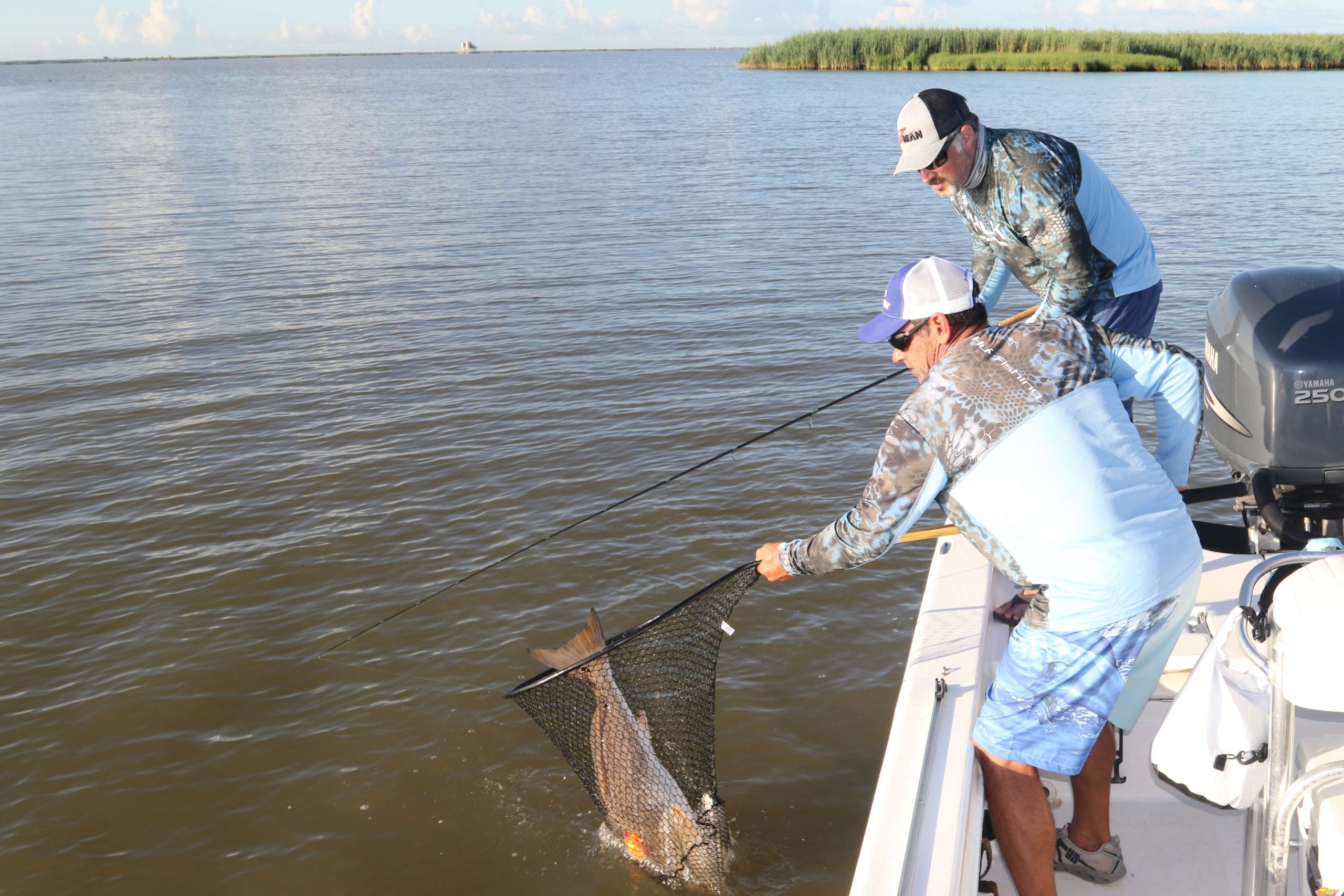
Bull tips
Great thing about bull redfish is their bravado. No fish will tolerate boats running right over them, but given proper spacing, these chunky reds go wherever they want and eat whatever they want. Find a feeding school and you’re gonna feel the power.
Bait diversity: Bulls seldom pass on natural baits like jumbo shrimp, pogies and cut mullet or ladyfish, but artificials are more time-efficient. You can cover more area and quickly respond to sudden sightings.
Topwaters offer a great tool for locating reds, as their boils and follows will help you dial in the school’s location. With subterminal mouths, reds often miss topwater bites, but a motivated fish will pierce the surface for a top-down attack. Even the failed attempts are a blast and if you’re quick with a subsurface follow-up bait, the fish and many of its schoolmates are quick to oblige.
Lead head jigs with swimming tails, shrimp bodies or split tail jerkbaits make solid choices for follow-ups or open-water presentations. Fishing any of these baits under a popping cork or clacking cork rig adds an appealing element by stimulating envious reds with the sounds of surface feeding.
Around marsh perimeters and anywhere vegetation grows, bulls love spinnerbaits — either traditional safety pin style frames with clips for interchangeable jig heads and soft plastic bodies, or the fixed form of inline spinners. Basically beefy versions of the stuff we throw for largemouth bass, walleye and freshwater trout, these spinnerbaits boast heavy gauge wire that’ll stand up to a bull red’s crushing jaw power.
Adding crankbaits, swimbaits and weedless gold spoons to the mix completes a well-rounded bull red arsenal. Whatever you throw, consider that feeding competition means amped-up aggression. If you miss a strike or your fish shakes loose, resume the retrieve and hang on for the next wave of attack.
Watch for the signs: Feeding bulls put on quite a show, often boiling the water and showering baitfish. Hovering birds often indicate predators — possibly redfish — below, while oily slicks from recently attacked baitfish schools can also guide your search.
On sunny days, watch for reddish to oranges masses, or dark shadows in dimmer. “Nervous water” — wakes created by bulls on the move are dead giveaways.
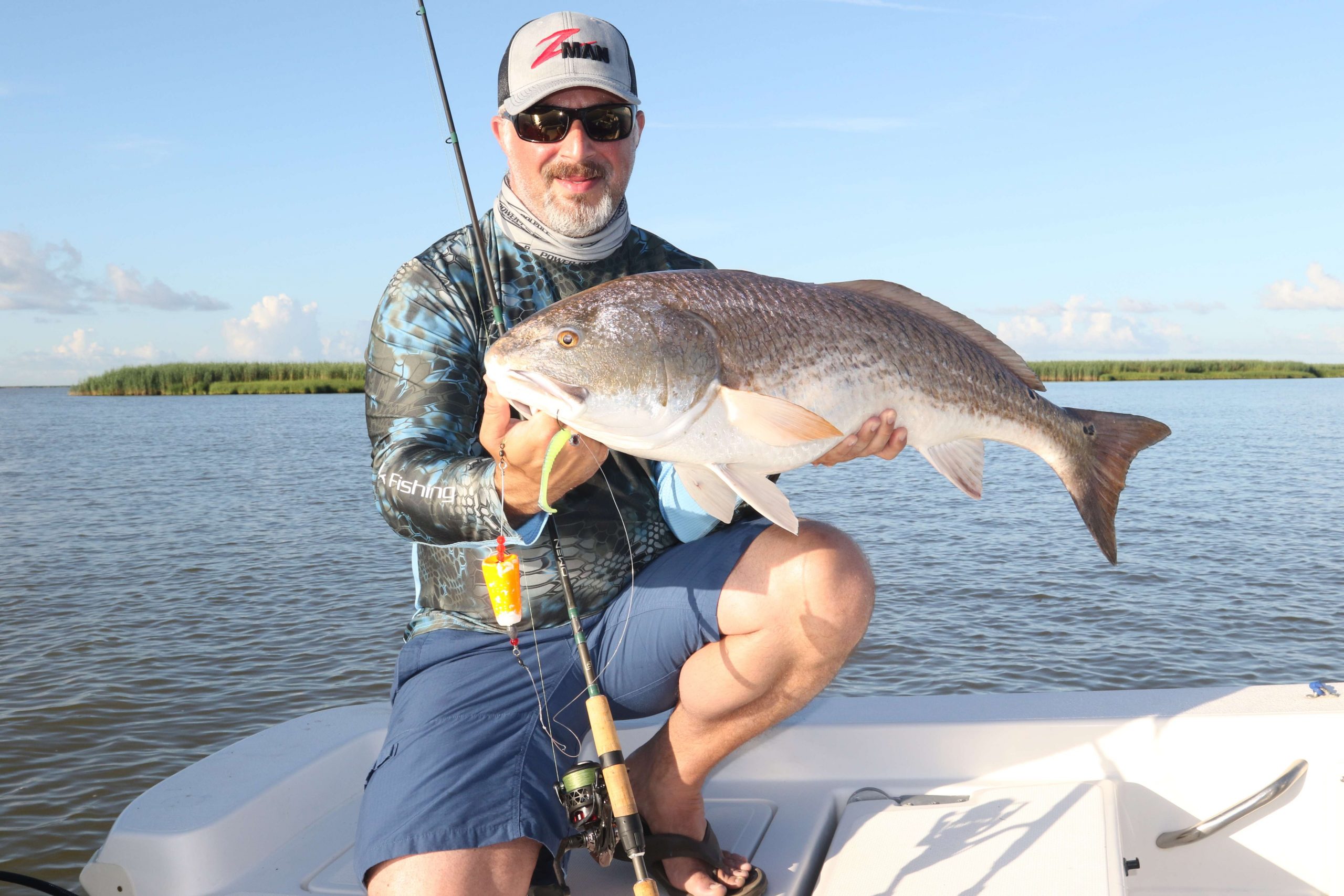
The approach: Essential to working a school of bull reds is GPS anchoring, like Minn Kota’s Spot-Lock for quietly holding in deeper areas and shallow water anchors — Power-Pole, Minn Kota Raptors — for the meager depths. Keep your distance, let a school come to you and multiple opportunities are common.
Often, a hooked red will charge the boat with several schoolmates literally trying to take the meal out of his mouth. This is when a jig or soft body swimbait can score the double-header.
One of the most amazing characteristics of bull reds is how stealthy they can be. It’s not uncommon for anglers on the hunt to look down and suddenly spot a crimson convoy rolling past the boat. Give a big redfish 3 feet of depth and he can slip past even the sharpest eye, unless he surges to eat something or suddenly changes direction.
To that point, savvy anglers will “bump” (surge) the trolling motor to goose the school just enough to make them disclose their position. The reds typically rise up but settle back into a fishable position.
Just don’t rush the situation by running up on the fish with the outboard engine. Even the brazen bulls have their limits, and once they’ve had enough, they’ll bolt.
Take the bull by the horns: Once committed, redfish bite with authority and run like they stole something. A 7- to 7 1/2-foot medium-heavy spinning outfit with 30-pound braid and a 30-pound fluorocarbon leader gives you plenty of leverage without overpowering the fight and fizzling the fun.
Expect several surging sprints, a couple frantic dashes around the boat and a rod-bending defiance that’ll have you wondering how many fish you’ve actually hooked. Let the fish run when it wants to run, but leverage every resting moment to gather line with a smooth cadence of pumping up and reeling down.
A wide frame landing net greatly facilitates capture, but don’t make the mistake of simply dipping and lifting, or that big red weight will bend your net like a wire clothes hanger. Scoop you fish into the mesh, turn the net handle vertically, grab the top of the net frame and lift your fish with all the weight supported by the mesh.
Redfish have no teeth, but considering a bull’s weight, your best grip is inside the bottom edge of the gill flaps. There’s plenty of space for a secure hold without touching the actual gills, so lift with one hand, slide the other under that broad belly and smile for camera.


